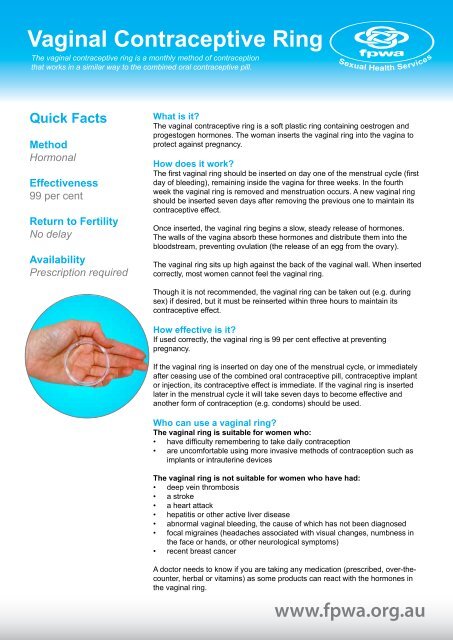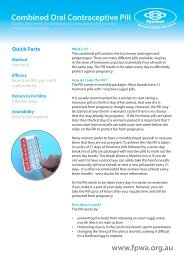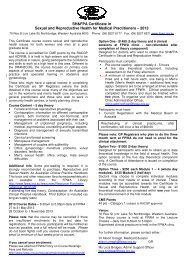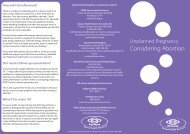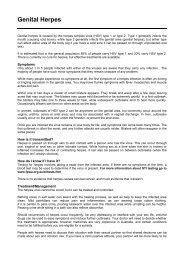Vaginal Contraceptive Ring - FPWA Sexual Health Services
Vaginal Contraceptive Ring - FPWA Sexual Health Services
Vaginal Contraceptive Ring - FPWA Sexual Health Services
- No tags were found...
You also want an ePaper? Increase the reach of your titles
YUMPU automatically turns print PDFs into web optimized ePapers that Google loves.
<strong>Vaginal</strong> <strong>Contraceptive</strong> <strong>Ring</strong>The vaginal contraceptive ring is a monthly method of contraceptionthat works in a similar way to the combined oral contraceptive pill.<strong>Sexual</strong> <strong>Health</strong> <strong>Services</strong>Quick FactsMethodHormonalEffectiveness99 per centReturn to FertilityNo delayAvailabilityPrescription requiredWhat is it?The vaginal contraceptive ring is a soft plastic ring containing oestrogen andprogestogen hormones. The woman inserts the vaginal ring into the vagina toprotect against pregnancy.How does it work?The first vaginal ring should be inserted on day one of the menstrual cycle (firstday of bleeding), remaining inside the vagina for three weeks. In the fourthweek the vaginal ring is removed and menstruation occurs. A new vaginal ringshould be inserted seven days after removing the previous one to maintain itscontraceptive effect.Once inserted, the vaginal ring begins a slow, steady release of hormones.The walls of the vagina absorb these hormones and distribute them into thebloodstream, preventing ovulation (the release of an egg from the ovary).The vaginal ring sits up high against the back of the vaginal wall. When insertedcorrectly, most women cannot feel the vaginal ring.Though it is not recommended, the vaginal ring can be taken out (e.g. duringsex) if desired, but it must be reinserted within three hours to maintain itscontraceptive effect.How effective is it?If used correctly, the vaginal ring is 99 per cent effective at preventingpregnancy.If the vaginal ring is inserted on day one of the menstrual cycle, or immediatelyafter ceasing use of the combined oral contraceptive pill, contraceptive implantor injection, its contraceptive effect is immediate. If the vaginal ring is insertedlater in the menstrual cycle it will take seven days to become effective andanother form of contraception (e.g. condoms) should be used.Who can use a vaginal ring?The vaginal ring is suitable for women who:• have difficulty remembering to take daily contraception• are uncomfortable using more invasive methods of contraception such asimplants or intrauterine devicesThe vaginal ring is not suitable for women who have had:• deep vein thrombosis• a stroke• a heart attack• hepatitis or other active liver disease• abnormal vaginal bleeding, the cause of which has not been diagnosed• focal migraines (headaches associated with visual changes, numbness inthe face or hands, or other neurological symptoms)• recent breast cancerA doctor needs to know if you are taking any medication (prescribed, over-thecounter,herbal or vitamins) as some products can react with the hormones inthe vaginal ring.www.fpwa.org.au
Practicing safe sex reduces the riskof contracting HIV and other sexuallytransmissible infections (STIs)<strong>Sexual</strong> <strong>Health</strong> <strong>Services</strong>Insertion and removalTo insert the vaginal ring you need to:1. squeeze it between your thumb and index finger2. gently insert it into your vaginaRemember the exact position is not important for the vaginalring to work. If you feel discomfort, simply slide the vaginalring further into your vagina. Your vaginal muscles will keepthe vaginal ring securely in place, even during exercise andsex.To remove the vaginal ring simply put your finger into yourvagina to hook the inside rim of the ring and pull it out.Advantages:• Less likely to experience side effects such as nausea,sore breasts and spot bleeding.• As the hormones don’t pass through the stomach, therisk of pill failure associated with diarrhoea and vomitingcan be avoided.• Women don’t have to remember to take a contraceptivepill every day.Disadvantages:• Women using a vaginal ring may increase the risk ofdeveloping a thrombosis (blood clot in the vein), whichcan lead to stroke or heart attack (this is the same forwomen taking the contraceptive pill).• It is important to drink plenty of water and move aroundregularly when flying, as there is a greater risk of clottingduring long flights.What if I forget to use it?If you are more than 24 hours late inserting a new vaginalring or have removed it for longer than three hours (eg.during sex) then insert the vaginal ring as soon as youremember; and use another form of contraception for thenext seven days (e.g. condoms).Emergency contraception (EC) is available over the counterat pharmacies if you have unprotected sex before youregain your contraceptive cover. EC is most effective whentaken within 24 hours of unprotected sex but can be takenup to 120 hours (five days) after sexual intercourse. ECeffectiveness decreases as time passes.Seek medical help if you develop any of thefollowing:• painful swelling of the calf (lower leg muscle)• severe chest pains or abdominal pain• a cough with blood-stained phlegm or breathlessness• a bad fainting attack or collapse• an unusual, severe or persistent headache• disturbance of speech or eyesight• numbness or weakness in your face or a limbIs there anything else I need to know?At this stage it is unclear whether the contraceptive effectof the vaginal ring is lowered when taking commonlyprescribed antibiotics (as is the case with the contraceptivepill).As a precaution, it is recommended that another formof contraception (e.g. condoms) be used when takingantibiotics. In addition to this, the vaginal ring needs to beworn for the next seven days after finishing the course ofantibiotics to resume contraceptive effectiveness.Although the vaginal ring does have some possible risks,few women actually experience serious health problemsfrom using it.As smoking increases the risk of high blood pressure andheart disease, women using a vaginal ring are stronglyadvised not to smoke.A vaginal ring does not protect against sexuallytransmissible infections (STIs).<strong>FPWA</strong> <strong>Sexual</strong> <strong>Health</strong> <strong>Services</strong>70 Roe Street, Northbridge, WA 6003Ph 08 9227 6177info@fpwa.org.auQuarry <strong>Health</strong> Centre for under 25s7 Quarry Street, Fremantle, WA, 6959Ph 08 9430 4544quarry@fpwa.org.au<strong>Sexual</strong> <strong>Health</strong> HelplineMetro 08 9227 6178Country 1800 198 205sexhelp@fpwa.org.au© © Family Planning Association of of WA WA (Inc) February 2009www.fpwa.org.au


